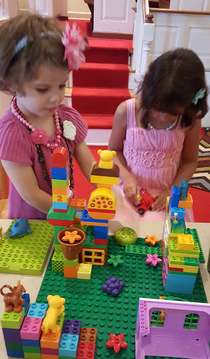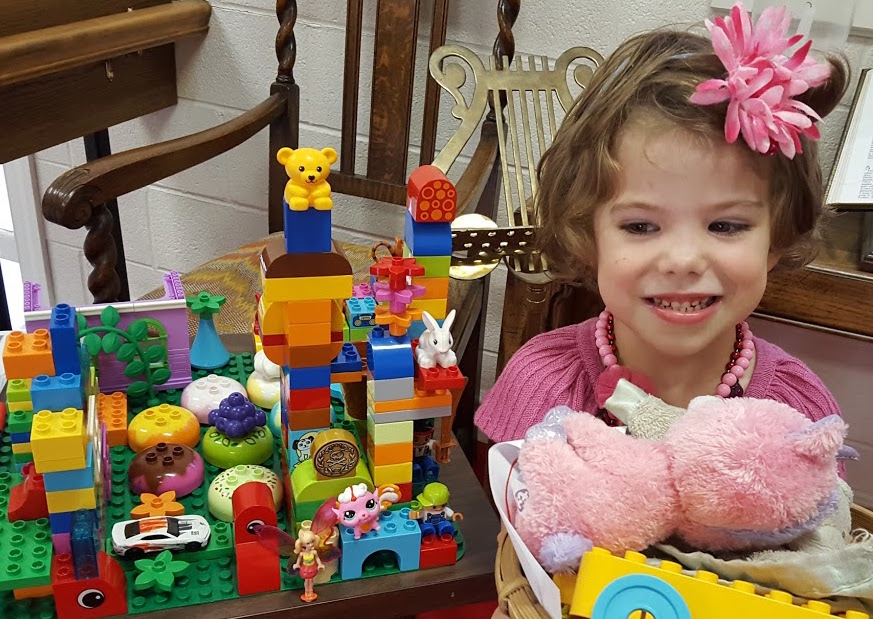 PRO TIP - Dump Legos onto carpet or padded surface BEFORE worship to avoid the tumult of plastic bricks shifting in bins. PRO TIP - Dump Legos onto carpet or padded surface BEFORE worship to avoid the tumult of plastic bricks shifting in bins. A deafening rumble filled the sanctuary. Bricks cascaded against one another and ricocheted off the walls. Towers smashed to the ground and rose from the rubble as playful fingers reveled in order and chaos. It was marvelous mayhem, but very slowly and very loudly, a glorious dwelling began to emerge. Our text for worship was the story of Solomon building the temple, so I encouraged the children to work together to build a house for God out of Legos. It was a great idea! Who knew that tiny plastic bricks could be so LOUD? I raised my voice, my gut twisting as I watched the faces of my congregation. Most strained to hear and stay focused. A few gave up listening to the sermon, but seemed perfectly happy watching the kids build. And of course, some sat arms crossed, eyes rolling, lips pursed, huffing with annoyance at each new crash. (Why is the perfect piece always at the bottom of the bin?) Now you are the body of Christ and individually members of it. – 1 Corinthians 12: 27 In our small but mighty church, we worship together (even when we don't like it) because we are one body—young and old, silent and speaking, calm and fidgeting. We welcome and engage everyone because we need each other. We envision lips singing as only lips can sing while hands lift, grasp, and carry as is their strength. We imagine minds blossoming with wisdom and ears straining for understanding. We see wild, unkempt hair bouncing in the wind of the Spirit and hearts beating in time, pumping the life-blood through this fully engaged body of worship. And it is unspeakably beautiful. And it is terribly hard. We don’t always enjoy the gifts of other members of the body – especially when they differ so vastly from our own. An ear is not made for dancing, so when she listens to the soft thuds and heavy breathing of a body in motion, she doesn’t grasp its joy. A foot is not designed to see, so he doesn’t recognize the glorious interplay of light and shadow through which he walks. But that doesn’t mean we don’t need each other. It doesn’t mean we aren’t part of the same body. It just means we are different—and that’s okay! If the whole body were an elder with a penchant for tradition, where would the sense of adventure be? If the whole body were a frazzled family just trying to get it all done, where would the sense of peace and patience reside? If the whole body were a toddler waving his arms in joy one minute and weeping with frustration the other, God save us. But as it is, God arranged the members in the body, each one of them, as GOD chose. If all were a single member, where would the body be? As it is, there are many members, yet one body. The eye cannot say to the hand, “I have no need of you,” nor again the head to the feet, “I have no need of you.” (1 Cor 12:18-20) We need each other – not just to worship but to survive. As much as we idolize the power of the individual, we build our society with common work and care for one another. A doctor needs a farmer to grow food. A farmer needs a politician to legislate good agricultural policy. A politician needs a teenager to speak truth and make passionate pleas to remember her true calling—to serve the body. Church is one of the few spaces left where people of all ages and experiences stand side by side, where we speak in unison and sing in harmony, where we unite into one body. If we don’t hear, see, touch, and even smell each other, how can we ever hope to connect and experience each other’s gifts? If we don’t share one sanctuary, how can we be knit together by one Spirit? I love the song “One” by U2, but when I looked up the lyrics I realized I was blissfully belting out the wrong words for a key phrase. I sang: “We’re one but we’re not the same. We’ve got to carry each other” – like it’s a burden or a charge we must accept. I sang this line as a call to action, which has its place, but that’s not the lyric. One small word makes all the difference: “We’re one but we’re not the same. We get to carry each other.” It’s not a burden, it’s a gift. To carry another’s heart and to offer yours in turn is a gift. To depend on one another is a blessing. To misunderstand and even grumble, but still love one another is sacred. To join many members in becoming one body is holy. We get to carry each other until that day, that glorious day, when we are truly One. As I offered the charge and benediction to the worshiping body, I held the house the children built for God—a patchwork of color and size, towers and windows, flowers and lions and dinosaurs and people joined into one sacred whole. It didn’t come together silently or easily, but it was beautiful and holy. I looked at faces filling the sanctuary: some radiant, a few disgruntled, all beloved, all connected. Together, we build a dwelling place of the Holy One not out of Legos or cinderblocks, but out of worship and service, out of tears and laughter, out of love for one another and for the world. We are the body of Christ, the church. Thanks be to God. This post originally appeared as "One Body" in Fidelia's Sisters, the online magazine of The Young Clergy Women Project.
0 Comments
 the author, giving the universal sign for "quiet please" - Note the smile with closed lips :) the author, giving the universal sign for "quiet please" - Note the smile with closed lips :) Good news! You have children at your church! And if they dart around chattering and giggling, they feel happy and comfortable within your community and your building. Good job church! Of course, these behaviors can be distracting and sometimes dangerous, so here are some tips for supporting kids as they learn how to behave in a church community: Your goal is to problem solve, not punish. If the child is doing something dangerous (like running through a crowded hallway or sliding down a bannister) intervene. Be careful to support, not scold.
|
SubscribeDon't miss out on any great content or events!
Categories
All
|
Site by King Communications

 RSS Feed
RSS Feed